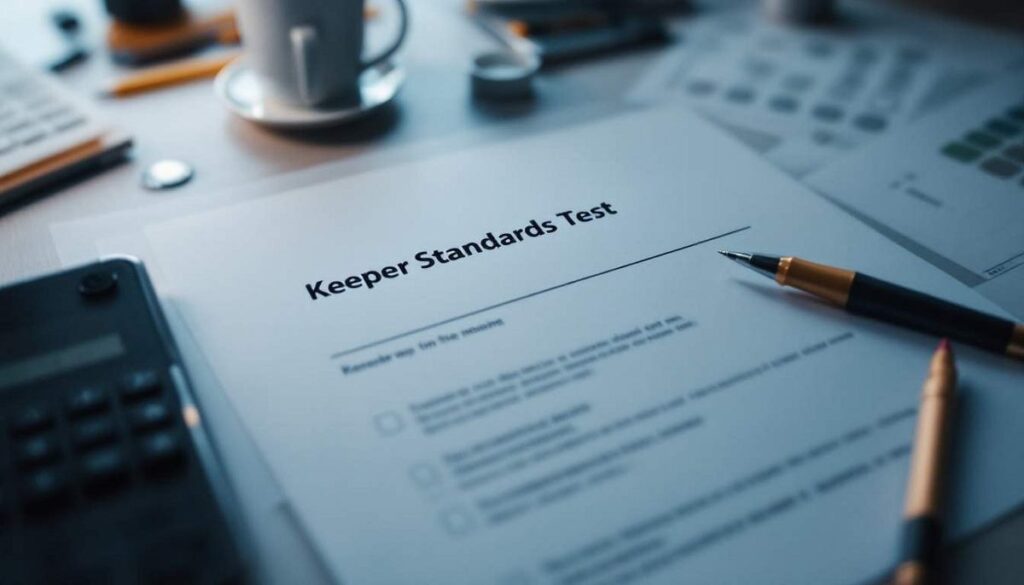
A goalkeeper sharpening his skills for the keeper standards test.
The Keeper Standards Test is a vital assessment tool in various professional fields, designed to measure the competence and readiness of individuals seeking to excel in their roles. This comprehensive guide will navigate the intricacies of the Keeper Standards Test, covering everything from its purpose to preparation strategies and interpretation of results.
What is the Keeper Standards Test?
The Keeper Standards Test is a standardized assessment that evaluates a candidate’s knowledge, skills, and abilities essential for performance in specific job roles. It is widely utilized in industries where a high level of proficiency is required, ensuring that only qualified individuals meet the standards necessary to succeed.
The Purpose of the Keeper Standards Test
The primary purpose of the Keeper Standards Test is to provide employers and educators with a reliable measure of an individual’s capabilities. By establishing a benchmark for performance, the test helps organizations make informed decisions regarding hiring, promotions, and training initiatives.
Moreover, it serves as a tool for self-assessment, allowing individuals to gauge their readiness for advancement in their careers. By identifying strengths and areas for improvement, candidates can take proactive steps toward achieving their professional goals. This dual function of the test not only aids in personal development but also enhances overall workforce competency, leading to increased productivity and job satisfaction across the board.
In addition, the Keeper Standards Test can be instrumental in shaping training programs within organizations. By analyzing the results, employers can identify common skill gaps among their workforce, allowing for targeted training initiatives that address specific needs. This strategic approach not only maximizes the effectiveness of training budgets but also fosters a culture of continuous learning and development within the organization.
Who Should Take the Keeper Standards Test?
Individuals pursuing a career in fields where the Keeper Standards Test is applicable should consider taking the assessment. This includes new graduates entering the workforce, employees seeking promotions, and professionals looking to demonstrate their skills.
Additionally, employers may encourage current staff to take the test to foster a culture of continuous improvement and to identify employees who are ready for more challenging roles. Overall, anyone aiming to validate their capabilities in a competitive job market would benefit from taking the Keeper Standards Test. Furthermore, industries such as healthcare, engineering, and information technology, where precision and expertise are paramount, often mandate such assessments to ensure that their teams are equipped with the necessary skills to meet the demands of their roles effectively.
Moreover, the Keeper Standards Test can serve as a valuable asset for career changers or those re-entering the workforce after a hiatus. By demonstrating their competencies through the test, these individuals can effectively bridge the gap between their past experiences and the new opportunities they are pursuing. This not only boosts their confidence but also enhances their appeal to potential employers who are looking for candidates that can quickly adapt and contribute to their organizations.
The Structure of the Keeper Standards Test
The Keeper Standards Test is meticulously designed with various sections that cover essential competencies relevant to the field. Understanding the structure of the test is crucial for effective preparation and success.
Sections and Components of the Test
The test typically comprises multiple sections, each focusing on a distinct area of knowledge or skill. Common components may include:
- Cognitive Abilities: Evaluating problem-solving and critical thinking skills.
- Technical Skills: Assessing specific technical proficiencies related to the job role.
- Situational Judgment: Testing candidates’ ability to respond to real-world scenarios.
- Behavioral Assessment: Understanding how personality traits align with job requirements.
By breaking down the test into these sections, candidates can better prepare by focusing their study efforts on each component. This structured approach not only helps in mastering the content but also allows candidates to identify their strengths and weaknesses in each area. For instance, those who excel in cognitive abilities may want to allocate more time to practice technical skills, thereby ensuring a well-rounded preparation strategy.
Time Allocation for Each Section
Time management is a key factor in successfully completing the Keeper Standards Test. Each section is allotted a specific amount of time, ensuring that candidates can showcase their abilities without the pressure of time constraints.
For example, a typical allocation might involve:
- Cognitive Abilities: 60 minutes
- Technical Skills: 45 minutes
- Situational Judgment: 30 minutes
- Behavioral Assessment: 15 minutes
Understanding the time limits for each section can significantly affect how candidates pace themselves throughout the test. It is advisable for candidates to practice under timed conditions to simulate the actual test environment. This practice can help them develop a rhythm and learn to allocate their time efficiently, ensuring they can complete all questions without rushing or leaving items unanswered. Additionally, familiarizing oneself with the types of questions typically asked in each section can further enhance confidence and performance on test day.
Preparing for the Keeper Standards Test
Preparation is crucial for success in the Keeper Standards Test. By utilizing appropriate study materials and adopting effective strategies, candidates can enhance their readiness and confidence.
Study Materials and Resources
To prepare adequately, candidates should seek various study materials tailored to the content of the Keeper Standards Test. Helpful resources may include:
- Official study guides: Providing an overview of the test structure and sample questions.
- Online courses: Offering in-depth lessons on relevant skills and knowledge.
- Practice tests: Allowing candidates to familiarize themselves with the format and timing.
- Study groups: Encouraging collaboration and discussion among peers for shared learning.
Utilizing a combination of these resources can create a well-rounded study plan, targeting different aspects of the test. Additionally, candidates may benefit from seeking out supplementary materials such as educational podcasts and webinars that delve into specific topics covered in the exam. These formats can provide insights from experienced professionals and educators, enriching the learning experience and offering practical tips that might not be found in traditional study guides.
Tips for Effective Study
Beyond just gathering study materials, implementing effective study strategies can greatly enhance retention and performance. Here are several tips:
- Set a Study Schedule: Allocate specific times for study sessions leading up to the test.
- Practice Mindfulness: Incorporate relaxation techniques to reduce stress and improve focus.
- Review Regularly: Continuous revision helps reinforce knowledge and skills.
- Simulate Test Conditions: Taking practice tests under timed conditions can build familiarity.
By following these tips, candidates can maximize their study efficiency and improve their chances of success on the Keeper Standards Test. Furthermore, it may be beneficial to incorporate varied study techniques, such as visual aids like flashcards or mind maps, which can cater to different learning styles. Engaging with the material through multiple senses can aid in memory retention and make the study process more dynamic and enjoyable. Additionally, maintaining a healthy lifestyle during preparation—ensuring adequate sleep, nutrition, and exercise—can significantly impact cognitive function, making it easier to absorb and recall information when it matters most.
Taking the Keeper Standards Test
On test day, understanding what to expect can alleviate anxiety and set candidates up for a positive experience. Familiarity with the test environment is essential for optimal performance. Knowing the layout of the testing center and the procedures can help candidates feel more at ease, allowing them to focus on the task at hand rather than the unfamiliar surroundings.
What to Expect on Test Day
Candidates should arrive at the testing location well-prepared, having brought all necessary materials, such as identification and any allowed resources. After checking in, test-takers can expect:
- Clear instructions on how the test will proceed.
- A brief orientation about the testing environment and rules.
- Time announcements to keep track of progress.
Maintaining a composed mindset is crucial. Engaging in deep breathing exercises before starting can help calm nerves and enhance concentration. Additionally, candidates may find it beneficial to visualize success as a way to mentally prepare themselves for the challenges ahead. This technique can create a positive mental image that reinforces their readiness and capability.
Strategies for Answering Questions
During the test, employing effective strategies for answering questions can significantly improve performance. Key approaches include:
- Read Questions Carefully: Ensure comprehension before selecting an answer.
- Eliminate Obvious Incorrect Answers: Narrowing down choices increases the chance of selecting the correct one.
- Manage Your Time: Keep track of time to ensure ample opportunity to complete all sections.
- Stay Positive: Maintain a positive attitude to boost confidence and focus.
By implementing these strategies, candidates can navigate the test day with confidence and clarity. Moreover, it is advisable to practice with sample questions or previous tests to familiarize oneself with the format and types of questions that may be encountered. This practice not only enhances understanding but also builds familiarity with pacing, allowing candidates to develop a rhythm that can be beneficial during the actual test.
Furthermore, candidates should consider discussing their preparation and experiences with peers or mentors who have previously taken the test. Sharing insights and tips can provide valuable perspectives and bolster confidence. Engaging in group study sessions or mock tests can also create a supportive environment, making the preparation process feel less isolating and more collaborative.
Interpreting Your Keeper Standards Test Results
After completing the Keeper Standards Test, understanding the results is a critical step towards utilizing the assessment effectively. Candidates need to interpret their scores and determine the next steps in their career journey.
Understanding Your Score
Results are typically presented in a score format, often including a breakdown of performance in each section. Candidates should take the time to review:
- Overall Score: Reflecting overall performance relative to the passing threshold.
- Section Scores: Providing insight into strengths and weaknesses across different areas.
- Relative Comparison: Sometimes, score reports include percentile rankings compared to other test-takers.
Understanding these components can aid candidates in making informed decisions about their professional development.
Next Steps After Receiving Your Results
Following the results, candidates should consider their next steps carefully. Depending on their scores, options may include:
- Pursuing additional training or education in weaker areas.
- Seeking feedback from mentors or industry professionals for improvement.
- Exploring job opportunities that align with their demonstrated skills.
Ultimately, the Keeper Standards Test is a valuable resource for growth, providing essential feedback for career advancement. By leveraging the results effectively, individuals can pave the way for future success.






